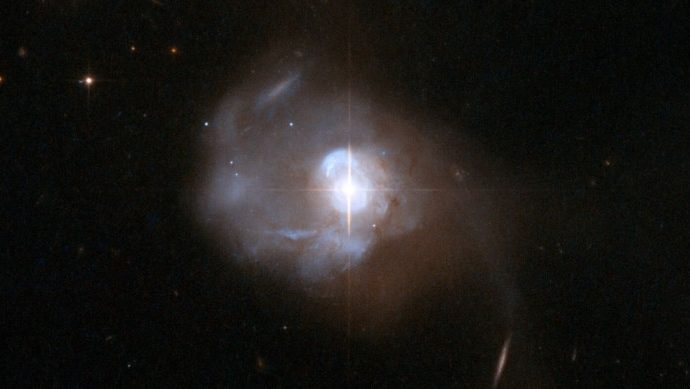Astronomers found oxygen beyond the Milky Way, in a galaxy not so far away.
Source: Interesting Engineering
Astronomers have found molecular oxygen — the one we breathe every day — in a galaxy beyond the Milky Way, according to a new study published in Astrophysical Journal.
Extra-galactic oxygen (not so) far, far away
The third-most common element in the universe after hydrogen and helium, astronomers used to think molecular oxygen (O2) would be smothered across interstellar space. But despite endless searching, no one had yet seen molecular oxygen outside of our galaxy — before now.
Junzhi Wang, an astronomer at Shanghai Astronomical Observatory in China, along with his colleagues saw the molecule’s signature traces in a galaxy called Markarian 231. Poised 560 million light-years away in the constellation Ursa Major, Markarian 231 is the closest galaxy to Earth with a quasar.
Quasars are supermassive black holes that whisk superheated gas around and around, giving off a brilliant glow seen far, far away.
The astronomers used radio telescopes in Spain and France to discover radiation at a wavelength of 2.52 millimeters, a calling card of O2, according to the team’s report in the February 1 Astrophysical Journal. “This is the first detection of molecular oxygen in an extragalactic object,” said Wang.
This find is also the most molecular oxygen ever seen beyond the solar system. In the past, astronomers had witnessed the molecule in only two star-forming clouds inside the Milky Way; the Rho Ophiuchi cloud and the Orion Nebula. Astronomers hypothesize that the shortage of interstellar oxygen is due to O2 atoms and water molecules freezing onto dust grains, sweeping up the oxygen from space.
In stellar nurseries like the two clouds mentioned above, the shockwaves from bright newborn stars can rip water ice away from dust, freeing oxygen atoms to reconnect with one another, forming molecules.
However, molecular oxygen is rare — even in the Orion Nebula — where hydrogen molecules outnumber oxygen molecules one million to one. Hydrogen is also the predominant molecule in Markarian 231. Despite this, molecular oxygen is present across the outer rim of the galactic disk at abundances more than 100 times greater than that found in the Orion Nebula.
That’s “very high,” said Gary Melnick, an astrophysicist not involved in the work from the Harvard-Smithsonian Center for Astrophysics in Cambridge, in a Science News report. “There is no known explanation for an abundance of molecular oxygen that high.”
To verify that the radiation does arise from O2, Melnick said the team behind the discovery should keep watching for a second wavelength of the precious molecule.
This is not easy, Wang said to Science News, because other radiation-emitting molecules exist at the same wavelengths. To confirm the presence of O2, the scientists made repeated scans through a vast catalog of molecules that radiate wavelengths similar to the one detected and found that no one had ever witnessed any of the candidate molecules in space.
Save, of course, for oxygen.
“It is guilt by elimination, if you will,” says team member Paul Goldsmith, an astronomer at the Jet Propulsion Laboratory in Pasadena, California, to Science News. One possibility for the presence of abundant O2 is that Markarian 231 goes through a more vigorous version of the oxygen-forming process happening in the Orion Nebula.
The nearby galaxy is a productive star factory, forming new stars 100 times faster than the Milky Way, and smearing the universe with 700 solar masses of gas annually.
High-speed gas ejected from Markarian 231’s center might smash into the gas of its disk, shaking water loose from dust grains, allowing the formation of oxygen molecules.
This oxygen could make the nearby galaxy even more productive because, when the oxygen molecule emits enough radiation, galactic gas cools enough to collapse inward; a boon to the formation of new stars.
We live in interesting times, but some of the most interesting things in the universe take us far beyond the reaches of our galaxy.
Source: Interesting Engineering

































Leave a Comment
You must be logged in to post a comment.